Slide maker “WLS”
probably William Low Sarjeant, 1851-1924
by Brian Stevenson
last updated November, 2014
Slides from this maker bear rectangular labels with
hand-drawn grids, handwritten specimen descriptions, and the initials “W.L.S.” (Figure 1). The amateurish
nature of these labels suggests that the maker was not a big-time professional
mounter. Almost all of them also carry a retail label from Stanley, Railway Approach, London Bridge.
Evidence indicates that “W.L.S.” was probably William Low Sarjeant, who lived in the London area and produced microscope
slides from 1873 onward. Moreover, he is known to have had a business
relationship with W.F. Stanley.
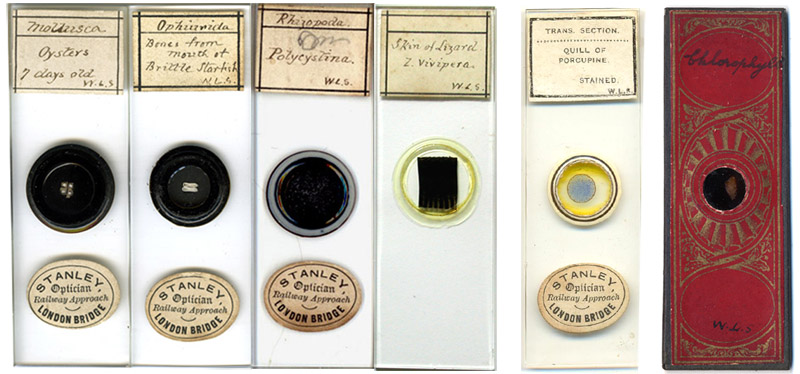
Figure 1. Examples of microscope slides bearing the initials
“W.L.S.”. Another slide by this maker is illustrated in Bracegirdle’s
‘Microscopical Mounts and Mounters’, plate 34, slide D. Almost all known slides
by this maker also carry trade labels from William F. Stanley. Similar slides that lack a trade label may have had them removed by an owner, or they may been acquired directly from the maker. Slides with type-set labels are very uncommon. The slide to the far right bears “W.L.S.” in the same handwriting as the other illustrated slides, although the specimen description, “Chlorophyll”, looks to have been written by someone else. The papering style was common in the 1860s-70s, so this may have been another person’s work that was acquired later by W.L.S.
William Low Sarjeant was born in January, 1851, in Bethnal
Green (now part of London). William’s father, whose name is currently not
known, was a “commercial traveler”
(traveling salesman). He was not at home on the day of the 1851 census. The
household consisted of William’s mother, Mary, a one year-old sister (also
named Mary), a 17 year-old servant girl and a 12 year old “nurse” (possibly William’s wet-nurse). The employment of two
servants suggests that the Sarjeants were moderately well-off.
William grew up to be a scientist / engineer. The 1881
census recorded his occupation as “Scientific
Experimentalist”, and the 1891 census listed him as a “Civil Engineer”.
Sarjeant developed interests in numerous aspects of biology.
In 1873, he wrote brief notes to Hardwicke’s
Science-Gossip on the self-heal plant, Prunella
vulgaris, and the goat moth, Cossus
ligniperda. The following year, Sarjeant advertised in the same magazine
for butterfly specimens in exchange for microscope slides (Figure 2). At that
time, his address was 6 Dagnall Park Terrace, Selhurst, Surrey.
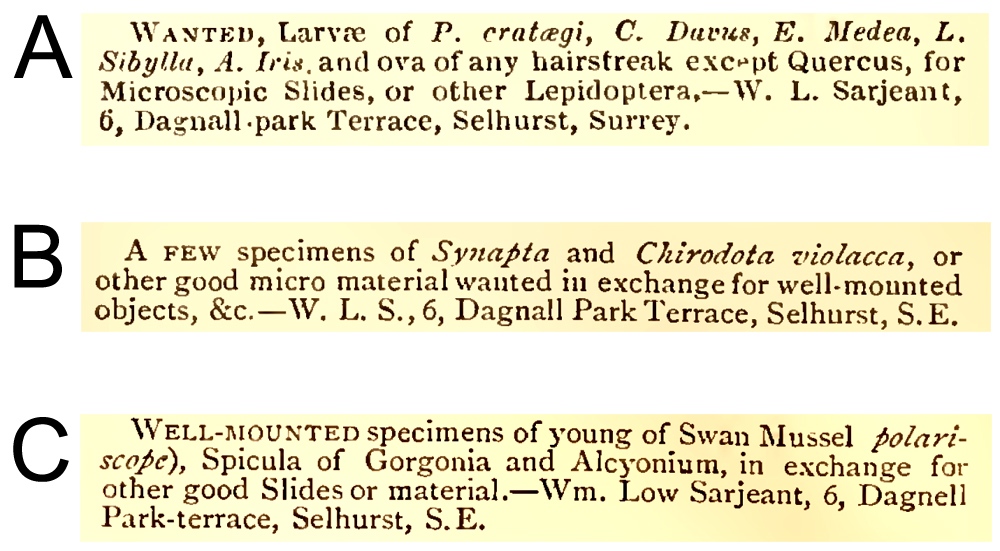
Figure 2. Exchange
advertisements from William Low Sarjeant, appearing in Hardwicke’s
Science-Gossip in 1874 (A) and 1877 (B and C). Note that he used his initials for the exchange offer shown in panel B.
Sarjeant joined the Croydon Microscopical and Natural
History Club on September 19, 1877. He displayed a “new and very ingenious section cutting machine” which he had
invented, at the December 18, 1878 meeting of the club. At that time, he lived
at Andaman Villa, Portland Road, South Norwood, S.E. The club’s “Proceedings” recorded numerous exhibits
by Sarjeant over the years. During his early years with the club, many of these
were objects for the microscope, some or all of which may have been his own
preparations. These included “diatoms
from Peruvian guano”, “radial section
of pine, polarized” and “horizontal
section of human foot (foetal); vertical section of scalp” (all during
1879), “quill of porcupine stained,
skeleton larva under polarised light” (during 1880), and “dredgings, Mid-Pacific,
2425 fathoms (H.M.S. 'Challenger')”
(during 1890)
At the time of the 1881 census,
Sarjeant lodged with a widow at 11 Wallston Road, Croydon, Surrey.
From the early 1880s onward, Sarjeant exhibited a strong
interest in photography. For the December 12, 1883 meeting of the Croydon
Microscopical and Natural History Club, “Mr. Low Sarjeant .. read a paper, entitled ‘The
Photography of Microscopic Objects, and Lantern Transparencies’. Mr. Low Sarjeant practically illustrated his paper by taking
Photographs of Microscopic Objects which were afterwards shown by means of a
magic lantern upon a screen. .. The following objects were exhibited: .. Mr.
Low-Sarjeant, Apparatus for MicroPhotography, in illustration of his paper”.
Sarjeant was an active member of the club’s Photographic Sub-committee.
On April 2, 1886, W.F. Stanley and W.L. Sarjeant were
issued patent number 4624 for a new form of actinometer. A surviving example of
their device is shown in Figure 3. This early exposure meter was useful for
determining exposure time when taking a photograph. The circular brass box
holds a roll of light sensitive paper (having been soaked in bromide salt). A
short length of the paper would be pulled out and exposed to light. The paper
then darkened, and its tint was compared with a reference.
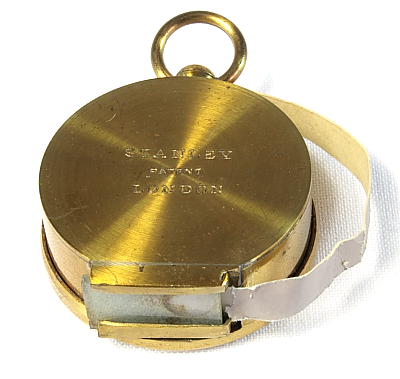
Figure 3. An actinometer produced by Stanley, from the design patented by Stanley and Sarjeant. It is roughly the size of a pocket watch, and was intended to be similarly worn on a chain.
By 1886, Sarjeant was elected Honorable Secretary of the
Croydon Microscopical and Natural History Club. He was noted in that post by
the 1888 Naturalists’ Directory, which
also recorded his address as 7 Belgrave Road, South Norwood, London. The 1891
census reported him to have been a lodger at that house. In 1891, Sarjeant was
elected to the Club’s Council.
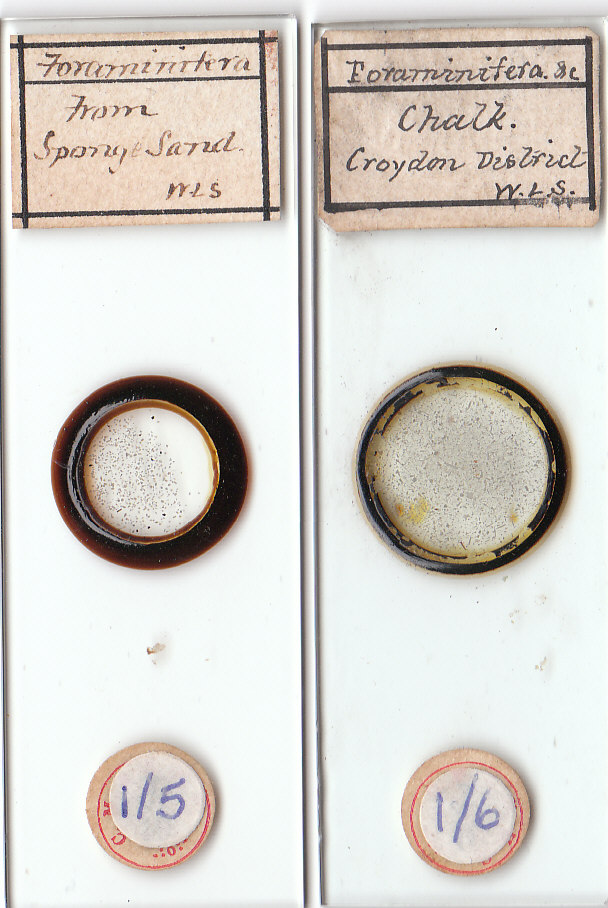
Figure 4. Two microscope slides from the Croydon Natural History and Scientific Society (previously the Croydon Microscopical and Natural History Club). The Society presently holds 10 WLS slides in its collection.
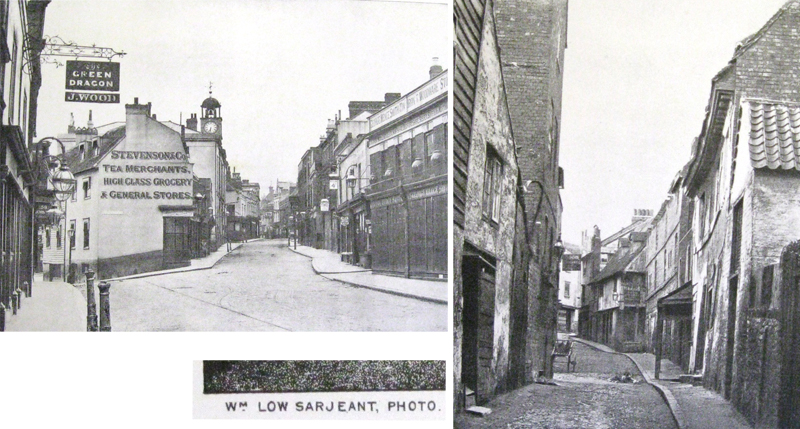
Figure 5.
Two photographs of Croydon by William Low Sarjeant, and a detail of an inset showing his name. These and other pictures by him were included in John Ollis Pelton’s 1891 book Relics of Old Croydon.
William Low Sarjeant emigrated to New Zealand in 1895. The Proceedings
and Transactions of the Croydon Microscopical & Natural History Club reported, “former Hon. Secretary, Mr. Low Sarjeant,
has unfortunately been obliged to leave England during the year on account of
his health. Mr. Low Sarjeant was an accomplished worker in the Photographic Section. As a mark of appreciation
of his services a testimonial, consisting of a gun and accessories, was
subscribed for by members of the Club, and presented to him on April 6th. Mr.
Sarjeant was also, on March 20th, elected an honorary member of the Club, so
that his connection with us is not entirely severed. I may add that Mr.
Sarjeant has presented to the Club, a camera and stand and 273 lantern-slides”.
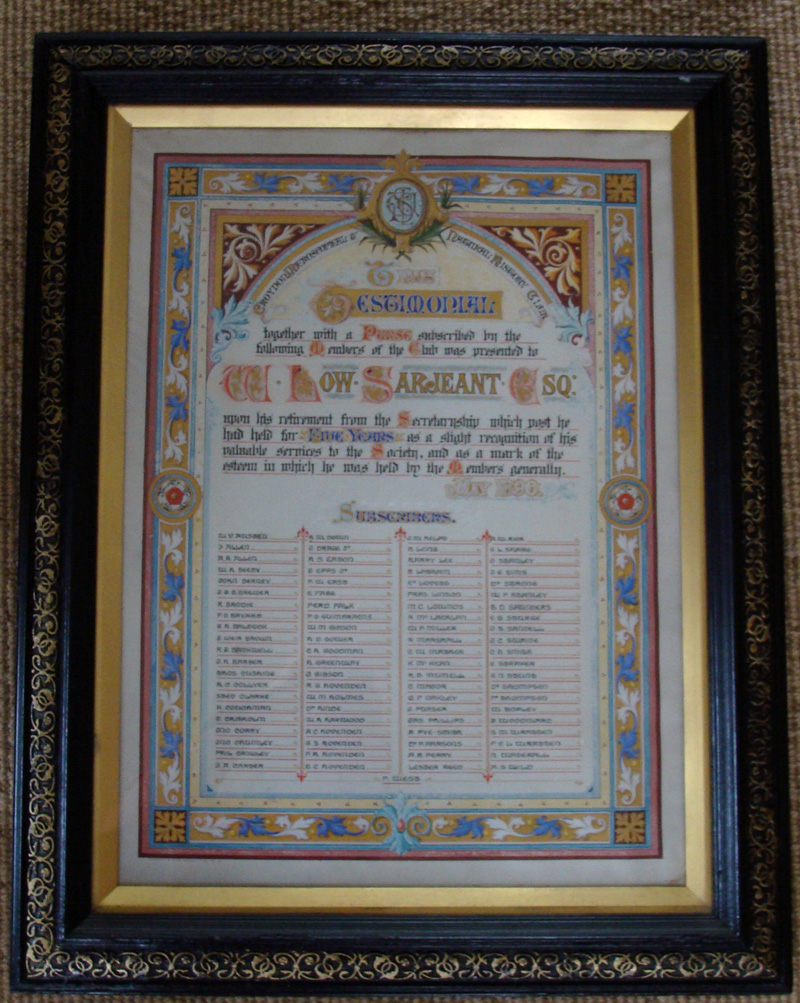
Figure 6. The certificate of appreciation awarded to William Low Sarjeant by the Croydon Microscopical and Natural History Club in 1890, prior to his departure for New Zealand. Courtesy of Cathy Knight.
The 1905-06 New Zealand electoral rolls recorded Sarjeant working as a “machinist” in Kohukohu, Bay of Islands, Northland. Family traditions holds that he was a watch maker and repairer. The long-time bachelor finally married in New Zealand, to
Margaret Dennison Gray. The couple had four daughters. William died on 18 September, 1924, in Kohukohu.
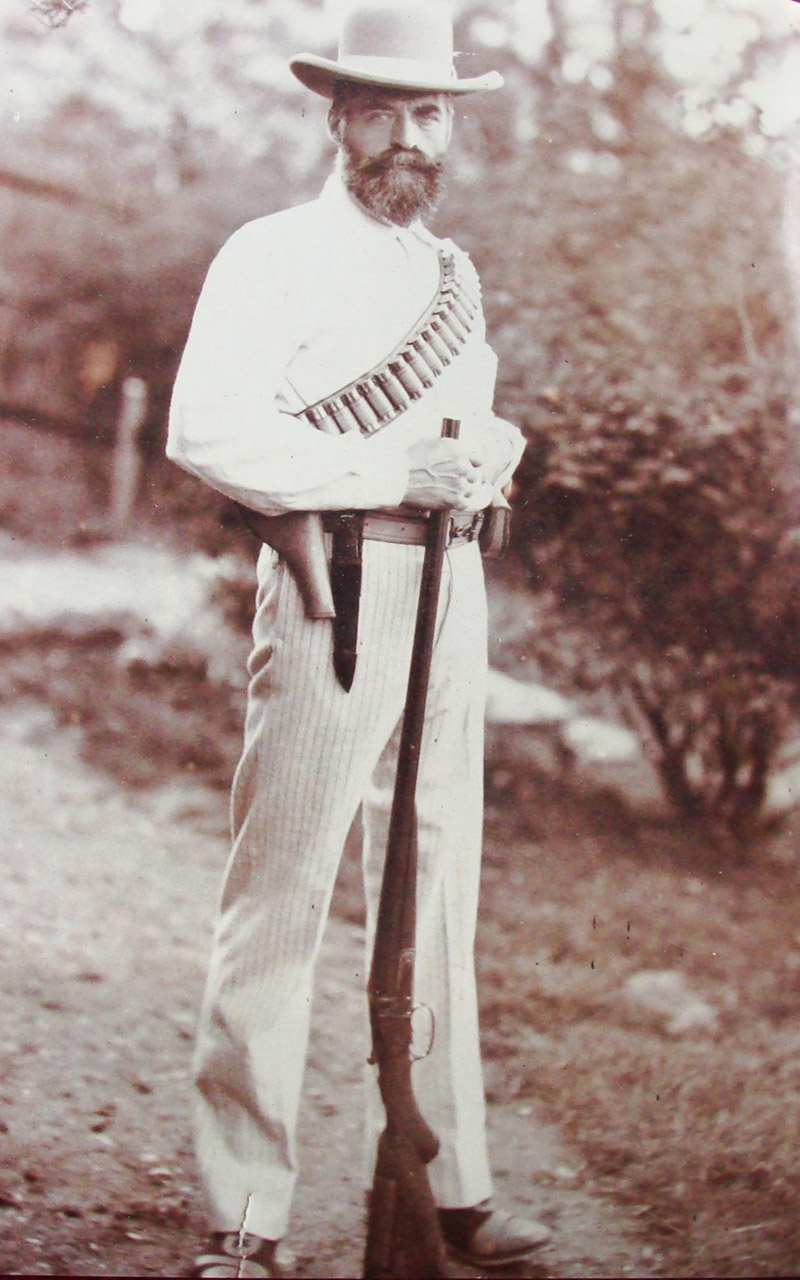
Figure 7. An undated photograph of William Low Sarjeant, in New Zealand. Courtesy of Cathy Knight.
Resources
Many thanks to Cathy Knight, great granddaughter of William Low Sarjeant, for providing information and images of her ancestor, and John Greig of the Croydon Natural History and Scientific Society, for information and pictures of the Society’s holdings by Sarjeant.
Resources
Bracegirdle, Brian (1998) Microscopical Mounts and Mounters, Plate 34, page 173, Quekett Microscopical Club, London
Early Photography (accessed July, 2011) Picture of
a Stanley-Sarjeant actinometer,
http://www.earlyphotography.co.uk/site/entry_E100.html
Encyclopedia of 19th century
photography (accessed July, 2011) Actinometers and exposure measurement,
http://19th-century-photography.blogspot.com/2010/12/blog-post.html
England census and birth records, accessed through ancestry.co.uk
Hardwicke’s Science-Gossip (1874)
Exchange offers, Vol. 10, page 48
Hardwicke’s Science-Gossip (1875)
Exchange offers, Vol. 11, page 284
Hardwicke’s Science-Gossip (1877)
Exchange offers, Vol. 13, pages 24 and 216
Hardwicke’s Science-Gossip (1886)
Note on the Croydon Microscopical and Natural
History Club, Vol. 22, page 42
The Naturalists’ Directory (1888)
Sarjeant, W. Low, page 256, S.E. Cassino, Boston, Mass.
New Zealand electoral rolls, accessed through
ancestry.com.au
Patents for Inventions (1897) “4624. Stanley, W. F., and Sarjeant, W. L., April 2. (1886), Actinometers. The sensitive paper, which is prepared from a bromide salt (instead of the usual chlorine salt) is rolled round a pin in a small circular metal case and brought out through a slot in the case and through a box with a glass top fitted on the edge. The glass is partly covered with tinted paper, by which the exposure is estimated. The actinometer may be suspended from the watch chain”. Her Majesty’s Stationery Office, London
Pelton, John O. (1891) Relics of Old Croydon: a Record of a Few Facts and Features Worthy of Remembrance Regarding the Locality Affected by the Croydon Improvement Scheme, Roffey and Clark, Croydon
Proceedings and Transactions of the Croydon Microscopical & Natural History Club (1878) Notes on meeting of Dec. 18 (page xii) and List of Members
Proceedings and Transactions of the Croydon Microscopical & Natural History Club (1879) Notes on specimens exhibited at meetings, pages xxv, xxviii,
xxxi, xxxiii and xxxviii
Proceedings and Transactions of the Croydon Microscopical & Natural History Club (1880) Notes on specimens exhibited at meetings, pages xliv, xlv,
xlvi, liv and lx
Proceedings and Transactions of the Croydon Microscopical & Natural History Club (1883) Notes on specimens exhibited at meetings, pages cxlv and clix
Proceedings and Transactions of the Croydon Microscopical & Natural History Club (1889) List of exhibitors of
microscopes and objects of interest at twentieth Annual Soiree, November 20th,
1889, page cxx
Proceedings and Transactions of the Croydon Microscopical & Natural History Club (1890) Notes on specimens exhibited at meeting, page clviii, and report of the Photographic Sub-Committee, page cxlix
Proceedings and Transactions of the Croydon Microscopical & Natural History Club (1891) Officers for 1891, page 20
Proceedings and Transactions of the Croydon Microscopical & Natural History Club (1894) The President’s address, pages liv-lv
Sarjeant, W.L. (1873) Self-heal, Hardwicke’s Science-Gossip, Vol. 9, page 46
Sarjeant, W.L. (1873) Cossus, Hardwicke’s Science-Gossip, Vol. 9, page 188
Sarjeant, William Low (1875) Sphinx convolvuli, Hardwicke’s Science-Gossip, Vol. 11, page 278






